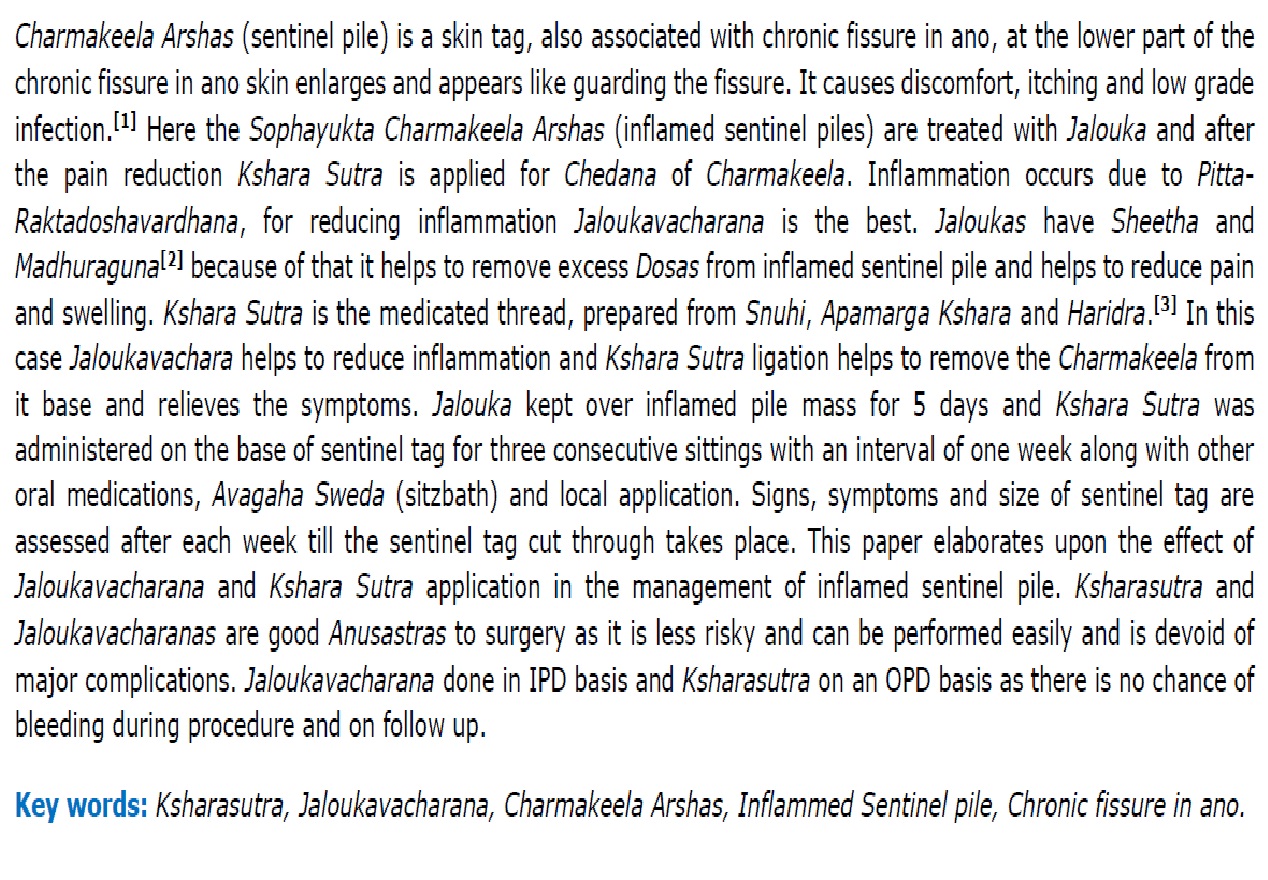A case study on Sophayuktha Charmakeela Arshas
Keywords:
Ayurveda, Jaloukavacharana, Ksharasutra, Charmakeela Arshas, Inflammed Sentinel pile,, Chronic fissure in ano, Case studyAbstract
Charmakeela Arshas (sentinel pile) is a skin tag, also associated with chronic fissure in ano, at the lower part of the chronic fissure in ano skin enlarges and appears like guarding the fissure. It causes discomfort, itching and low grade infection.[1] Here the Sophayukta Charmakeela Arshas (inflamed sentinel piles) are treated with Jalouka and after the pain reduction Kshara Sutra is applied for Chedana of Charmakeela. Inflammation occurs due to Pitta-Raktadoshavardhana, for reducing inflammation Jaloukavacharana is the best. Jaloukas have Sheetha and Madhuraguna[2] because of that it helps to remove excess Dosas from inflamed sentinel pile and helps to reduce pain and swelling. Kshara Sutra is the medicated thread, prepared from Snuhi, Apamarga Kshara and Haridra.[3] In this case Jaloukavachara helps to reduce inflammation and Kshara Sutra ligation helps to remove the Charmakeela from it base and relieves the symptoms. Jalouka kept over inflamed pile mass for 5 days and Kshara Sutra was administered on the base of sentinel tag for three consecutive sittings with an interval of one week along with other oral medications, Avagaha Sweda (sitzbath) and local application. Signs, symptoms and size of sentinel tag are assessed after each week till the sentinel tag cut through takes place. This paper elaborates upon the effect of Jaloukavacharana and Kshara Sutra application in the management of inflamed sentinel pile. Ksharasutra and Jaloukavacharanas are good Anusastras to surgery as it is less risky and can be performed easily and is devoid of major complications. Jaloukavacharana done in IPD basis and Ksharasutra on an OPD basis as there is no chance of bleeding during procedure and on follow up.
Downloads
References
Bhatt S. SRB Manual of Surgery. 5th ed. New Delhi: Jaypee the health science publisher; 2017.p 977-978
Ambikadatta Sastri. Susrutha Samhitha Sutrasthana Nibandha Sangrahakya Vyakya. 1st ed. Varanasi: Chaukhamba Publication; 2019.
Sastri, Chakradhatha, (Arshoadhikara Sloka No 145) Goodartha Deepika Vyakyana, S.T Reddiyar Kollam, 2014
Ambikadatta Sastri. Susrutha Samhitha Nidanasthana (2nd chapter Arshas Nidanam, Sloka No. 18), Nibandha Sangrahakyavyakya, Chaukhamba Publication, 2014
Ambikadatta Sastri. Susrutha Samhitha ChikitsaSthana (6th chapter, sloka no 7) nibandhasangrahakyavyakya, Chaukhamba Publication,2014
Ambikadatta Sastri. Susrutha Chikitsasthana, (17th chapter Visarpa, Nadistanaroga Chikitsa. Sloka no.33) Nibandha Sangrahakya Vyakya, Chaukhamba publication, 2018















